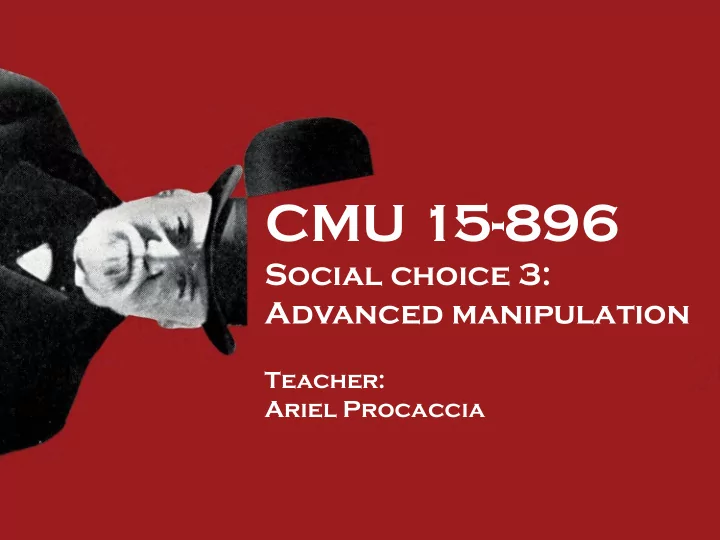

CMU 15-896 Social choice 3: Advanced manipulation Teacher: Ariel Procaccia
Recap • A Complexity-theoretic barrier to manipulation • Polynomial-time greedy alg can decide instances of -M ANIPULATION for = scoring rules, Copeland, Maximin,... these rules are easy to manipulate in practice • Some rules are NP-hard to manipulate: STV, ranked pairs,... 15896 Spring 2016: Lecture 3 2
Criticisms • What is the complexity of the Dictatorship-M ANIPULATION problem? • NP-hardness is worst-case, but perhaps a manipulator can usually succeed • Approaches: Algorithmic: for specific voting rules but o works for every reasonable distribution Quantitative G-S: for a specific distribution o but works for every reasonable voting rule 15896 Spring 2016: Lecture 3 3
Quantitative G-S • We’ll do this roughly, to capture intuitions rather than aiming for accuracy • The distance between two voting rules is the fraction of inputs on which they differ where the Pr is over uniformly random preference profiles • For a set , �∈� ��� = set of dictatorships, • ��� 15896 Spring 2016: Lecture 3 4
Quantitative G-S � is a manipulation pair for if • � � �� � � • Theorem [Mossel and Racz 2012]: , is onto, . Then ��� � manip. pair for � � are for a polynomial , where and � chosen uniformly at random 15896 Spring 2016: Lecture 3 5
Randomized voting rules • Randomized voting rule: outputs a distribution over alternatives • To think about successful manipulations we need utilities (assume strict preferences) � is consistent with � if • � � � � • Strategyproofness: � �� � � � � �� � where � is consistent with � 15896 Spring 2016: Lecture 3 6
Randomized voting rules • A (deterministic) voting rule is unilateral if it only depends on one voter o duple if its range is of size at most 2 o • A randomized rule is a probability mixture over rules � � if there exist � � such that for all , � � 15896 Spring 2016: Lecture 3 7
Randomized voting rules • Theorem [Gibbard 1977]: A randomized voting rule is strategyproof only if it is a probability mixture over unilaterals and duples Mixture over unilaterals and duples that is not SP? 15896 Spring 2016: Lecture 3 8
Randomization+approximation • Idea: can strategyproof randomized rules approximate popular rules? • Fix a rule with a clear notion of score (e.g., Borda) denoted • Randomized rule is a -approximation if for every preference profile , �∈� 15896 Spring 2016: Lecture 3 9
Approximating Borda Poll 1: What is the approximation ratio to Borda from randomly choosing an alternative? Θ 1/� 1. Θ 1/� 2. Θ 1/ � 3. Θ�1� 4. • Theorem [P 2010]: No strategyproof randomized voting rule can approximate Borda to a factor of � � � � 15896 Spring 2016: Lecture 3 10
Interlude: Zero-sum games -1 1 1 -1 15896 Spring 2016: Lecture 3 11
Interlude: Minimax strategies • Minimax (randomized) strategy minimizes worst- case expected loss (or maximizes the expected gain) • In the penalty shot game, minimax strategy for � � both players is playing � � • In the game below, if shooter uses � � Jump left: � � � 1 � � � 1 � � � o Jump right: � � 1 � � � 2� � 1 o � - Maximize min�1 � � �, 2� � 1� over � o 15896 Spring 2016: Lecture 3 12
Interlude: The Minimax Theorem • Theorem [von Neumann, 1928]: Every 2-player zero-sum game has a unique value such that: Player 1 can guarantee o value at least Player 2 can guarantee o loss at most 15896 Spring 2016: Lecture 3 13
Yao’s minimax principle � � 1 2 � 15 21 7 5 Approximation ratio � 15 21 4 8 � 15 21 13 17 � 15 21 15896 Spring 2016: Lecture 3 14
Yao’s minimax principle • Maximin Theorem The expected ratio of the best distribution over unilateral rules and duples against the worst preference profile is equal to the expected ratio of the worst distribution over profiles against the best unilateral rule or duple • An upper bound on the approximation ratio of the best distribution over unilateral rules and duples is given by some distribution over profiles against the best unilateral rule or duple • Gibbard’s Theorem this is also an upper bound on the best randomized strategyproof rule 15896 Spring 2016: Lecture 3 15
A bad distribution • 1 2 3 ∗ • Choose uniformly at c b d b a b random a d c • Each voter chooses a random d c a number � and ∗ in position � � ∗ � � puts � � � 2 • The other alternatives are � � � 1 � � � 2 ranked cyclically 15896 Spring 2016: Lecture 3 16
A bad distribution Poll 2: What is the best feasible lower bound on 1. 2. 3. 4. 15896 Spring 2016: Lecture 3 17
A bad distribution � ��� ∗ • For � • Unilateral rule: by looking at one vote ∗ is; need to there is no way to tell who “guess” among first alternatives • Duple: by fixing only two alternatives the � ∗ is probability of getting � 15896 Spring 2016: Lecture 3 18
Recommend
More recommend